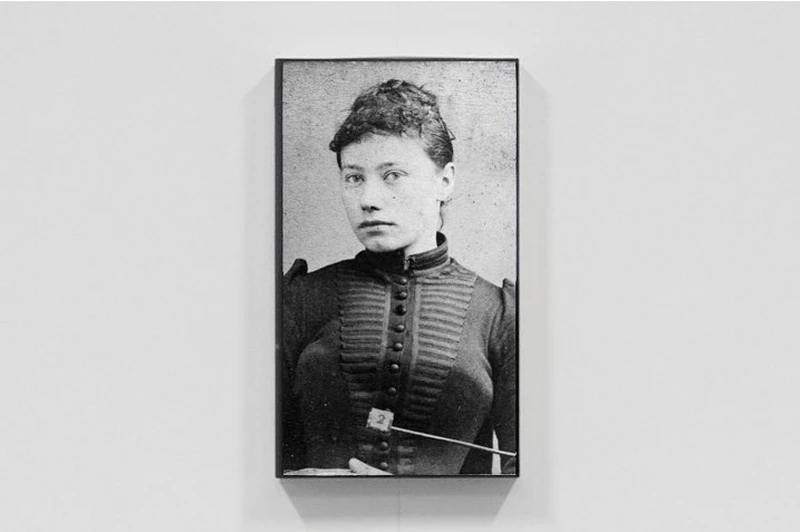Portrait: A Summer Show
7 Jul-12 Aug 2023


Frith Street Gallery presents Portrait, an exhibition of works by gallery artists considering the contemporary portrait through a range of perspectives and mediums. From sensitive images of loved ones to reappropriated portraits mined from the past, Portrait speaks of our innate desire to understand and document our fellow human beings, whether real or imagined.
For the work Sons (2011) Daphne Wright made life casts of her children and then painted them using a traditional technique of plaster mixed with pigment. In this piece, time has been frozen and an image of the boys’ growing bodies preserved forever, caught in an awkward moment of their development as they emerge as individuals. The intimacy of close relationships is explored too by Dayanita Singh, whose video work Mona Shayari (2013/2021) depicts her dear late friend and muse Mona Ahmed. The work emerged during one of Mona’s visits to Singh’s studio, when she asked to be recorded reciting all the shayari she knew in one single take. Shayari is a form of poetry that may be recited or sung and Mona loved to recite the couplets that described the pleasures and terrors of romantic love.
Marlene Dumas has often turned her attention to celebrity culture, excavating our relationship with the media and what it tells us about the famous. Her portrait Phil (2011) depicts the late music producer and convicted murderer Phil Spector. Celebrated for his Wall of Sound, Spector gave us profoundly moving pop songs but very publicly fell from grace and died serving his prison sentence in 2021. Also drawing from popular culture, Cornelia Parker’s Blue Shift (2002) captures Mia Farrow at a pivotal moment from the disturbing 1968 horror film Rosemary’s Baby and consists of four polaroid images of the actor’s face.
Both Tacita Dean and Fiona Tan adopt and transform archival materials. Found Postcard Monoprints (Actors) (2018) by Dean is a series of early twentieth-century postcards from the artist’s collection, featuring actors that range from unknown players to the stars of their day – Buster Keaton, Sarah Bernhardt and Rudolph Valentino among them. These images show the posturing of the actor, ready for public consumption, but now partially obscured, or perhaps embellished, by a monoprinting process.Tan’s Pickpockets is based upon rare and early police photographs of various petty criminals who had been arrested at the Exposition Universelle of 1889 in Paris. Tan was fascinated by these portraits and the unknown life stories of their subjects who hailed from internationally-diverse backgrounds. The individual piece shown here: Léonie Césarine Bise (2021), has had a spirited life story bestowed on her by the artist, a fiction written and voiced by art historian Sophie Berrebi.
Self-portraiture has long been a vehicle for formal experimentation and psychological exploration. In Fiona Banner’s Mirror (2007) the actor Samantha Morton is recorded in a performance in which she reads aloud for the first time a description of her nude self, written by Banner. This produces a moving dissociative portrait / self-portrait exploring the boundaries of text and image. Anna Barriball’s Mirror (standing) (2023) invites us obliquely to imagine a self-portrait. This life-size drawing has been made by placing paper against a full-length mirror, originally from her childhood home. Working steadily across the glass Barriball has replaced the reflective surface with pencil strokes. The viewer can almost make out their own reflection in the graphite surface creating a ghostly presence. In Thomas Schütte’s Anna (2014) the oval frame suggests a mirror and, in turn, a self-portrait. This ceramic plaque comes from a series which have been created by the artist drawing directly into the unfired clay. The subject points to an extensive stock of drawings and watercolours that constitute a central field of work in Schütte’s oeuvre.
For Daniel Silver, the history of painting, sculpture and psychoanalytic theory comes together in a new series of semi-abstract busts in unfired, oil-painted ceramic. With titles such as Mother and Clownthese elliptical portraits form surreal imagined families. Polly Apfelbaum is similarly engaged in the history of folk art and craft. The Barn Faces (2021) and drawing series Faces and Tails (2021) are inspired by circular Hex signs, developed from Fraktur, the elaborate illuminated folk art of the Pennsylvania German community, often found on the exterior of barns in her native Pennsylvania and serving a talismanic function. The faces appear to be half male, half female.
The exhibition is presented as part of 'Portrait Mode' – an international campaign celebrating portraiture on the occasion of the reopening of the National Portrait Gallery, London. It is accompanied by an online moving-image programme including work by Bridget Smith, Cornelia Parker, Fiona Tan and Raqs Media Collective.